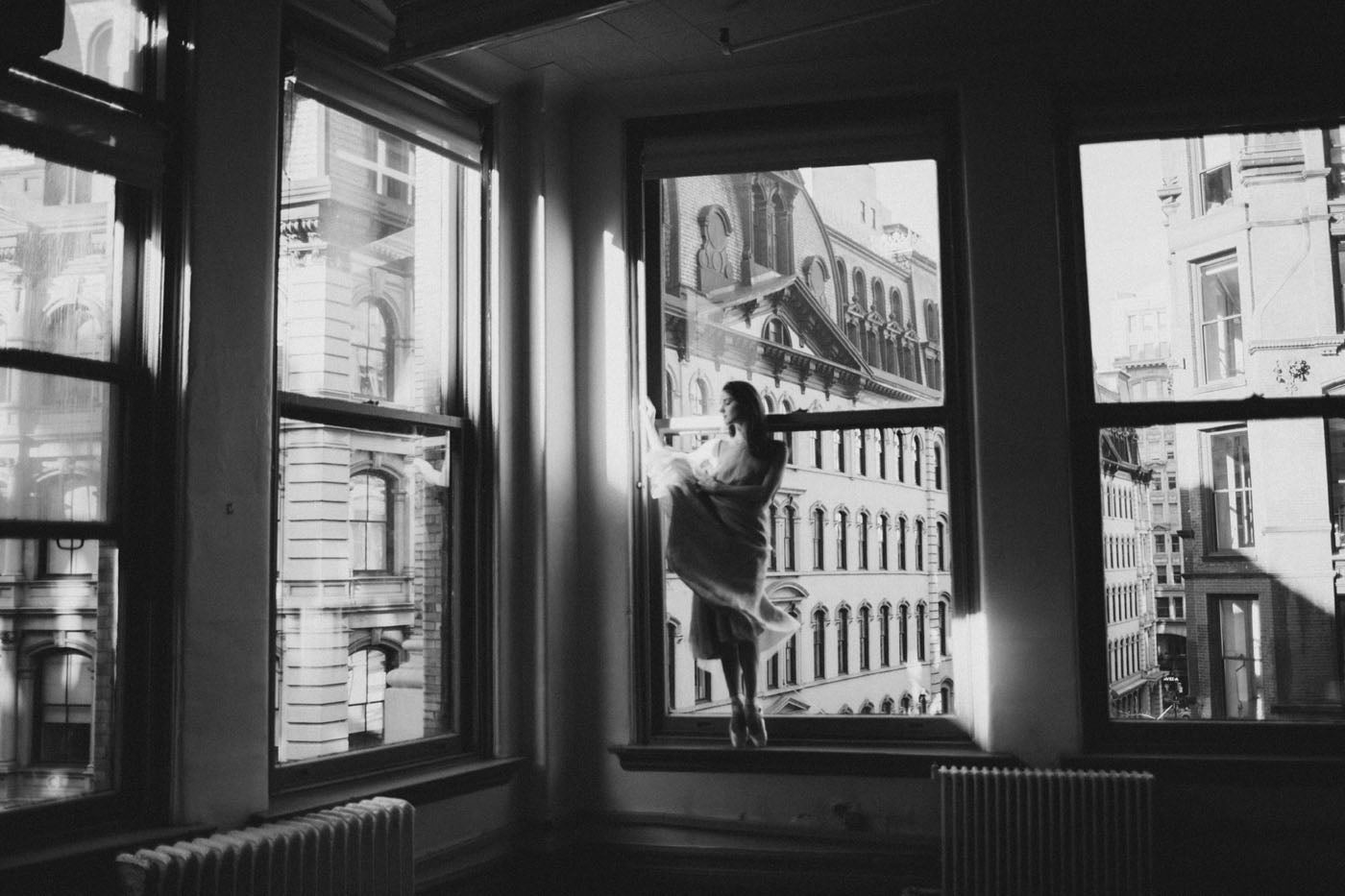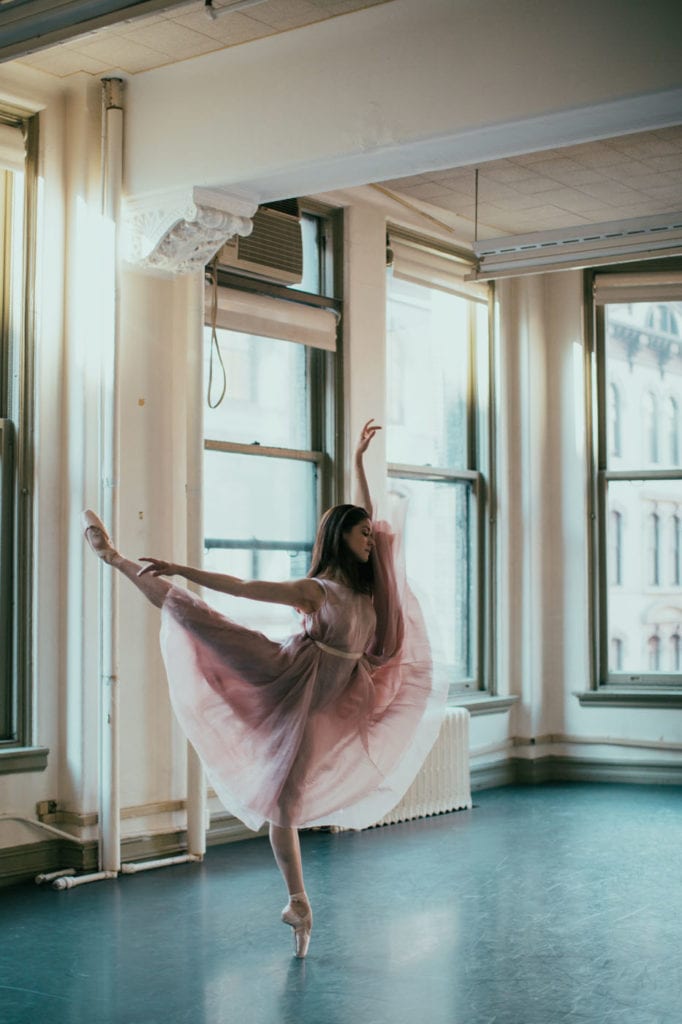Audiences in Toronto were given the opportunity to see the starlet compete for the Erik Bruhn Prize, in a heart-fluttering performance of the Bluebird pas de deux with Gabe Stone Shayer, and new choreography by Jeffrey Cirio.
“It was my first competition,” she says brightly, speaking by phone from California, “it was such an honour to represent ABT; to represent what the next generation of the company is. And it was really fun.”
Trenary, who joined ABT in 2011 and was promoted to soloist in 2015, was immediately noticed for her beauty, grace and drive. While still in the corps, she danced a number of soloist and principal roles, including Princess Florine in Ratmansky's “The Sleeping Beauty,” and the Youngest Sister in Antony Tudor's “Pillar of Fire.”
“We tried to portray the characters in Bluebird. Alexei helped a lot with that; he told us the story that the dancers are retelling to the court.” The Bluebird pas de deux is derived from classic French fairytale, in which the Princess Florine's sweetheart is turned into a songbird by a malicious step-mother.
ABT, with its rich narrative repertoire indulges Trenary's love of drama. “I enjoy telling a story and ABT has a lot of opportunity to do that. I'm more of a dramatic artist than a technically perfect artist, so it's something that I've been working on.
“I like figuring out how to make a fairytale more human, and the character more relatable.”
She takes cues from artists such as Alessandra Ferri—“my all time favourite dramatic artist,” Alina Cojocaru—“all time favourite Aurora,” and Julie Kent. “It's like watching these people live their lives, rather than play a character.”
Dancing Aurora in ABT's new “Beauty,” which premiered in 2015, “was a dream come true. I had to pinch myself constantly. It's something you dream about for so long.”
“It's a beautiful coming of age story, and I loved every second of it.” She danced the role in March at the Detroit Opera House, Michigan, and had her Met premiere in July, performing two shows at the Opéra Bastille in the summer.
“My first time in Paris was after I had just joined the Jacqueline Kennedy Onassis School, and coming back to dance Aurora was really special.”
Ratmansky was appointed artist in residence at ABT in 2009, and has since reshaped the company's repertoire, and aesthetic. Not without some growing pains, as Trenary recalls the “shock” of “being asked to move in a different way.
“Sometimes you found yourself fighting it, and then other times you find yourself saying, it's ok to approach movement differently.
“I know that I've only improved from the tactics he's provided me with. He gives you an image to think about and then all of a sudden you're able to do what you thought you couldn't.
“The feeling that you get when you're finally able to create the shape that he wants is the best feeling in the world.”
His newest ballet, “Whipped Cream,” with its diabetic synopsis of a boy who overindulges and falls asleep in a Viennese pastry shop, is set to music by Richard Strauss with designs by pop-surrealist Mark Ryden.
“It's kind of like if Willy Wonker and the Chocolate Factory and “The Nutcracker” had a baby.” “Whipped Cream” opens in March at the Segerstrom Center for the Arts, Costa Mesa, Calif., and Trenary is slated to dance Princess Praline on May 23 and June 27 & 29 at the Met.
Trenary will also return to Aurora in July, dancing “Aurora's Wedding,” act three of “Beauty” as part of ABT's Tchaikovsky Spectacular, with Herman Cornejo her Prince Désiré. The season also sees her reprise the title role in Ratmansky's 2012 ballet, “The Golden Cockerel.”
“It's a fun but extremely challenging role; very jazzerina. I trained in lots of different styles so I'm going back to my roots.”
Not afraid to change it up, Trenary has also taken opportunities to dance with ensembles outside the company, performing with Daniil Simkin's INTENSIO and Joshua Beamish's MOVE: the company. “I have always enjoyed working with different choreographers and challenging myself to move different ways; even after deciding to be classical dancer for my profession.”
“What's great about New York is that there are opportunities all over the place to take different classes. I took a heels class on Thursday night; it was awesome. Basically when I retire I'd like to be one of Beyonce's back-up dancers.”
All this was far from her mind two years ago. In 2013, Trenary suffered a series of injuries that sidelined her for several months, and put a question mark over her career. After a strong two years in the company, with Trenary already taking her moments to shine, she suffered a stress fracture in her foot. “While I was still in physiotherapy during the spring season at the Met, I started having back spasms, which worsened to the point where I couldn't move the entire left side of my body at one point.” Diagnosed with thoracic outlet syndrome, an injury common in violinists, Trenary began the slow process of recovery.
“I thought, ok, well, I had a good run. I figured I'd go back to dancing but I never saw myself getting to the level that I am now.”
While the brakes were on ballet, the self-confessed stage animal sought another creative outlet. “I auditioned for a play, and got into acting and I really enjoyed it. I continued even after I started dancing with ABT again. As I got stronger dancing, I realised that there was still more for me in dance. It wasn't over yet.”
A “very active” child, from Georgia, Trenary's parents encouraged her in activities such as horse-riding, martial arts, and basketball as well as dance. It wasn't until she attended ABT's summer intensive at age 12 that she started to realise her own potential. “For the first time, I surrounded by other young dancers who took it as seriously as I did; and it was normal.”
Like many young dancers, Trenary's teen summers were spent at ballet intensives. “I auditioned for two summer intensives in my life, SAB and ABT—and I got into ABT, and that was that.”
She was spotted by Franko de Vita and Raymond Lukens, the then directors of the Jacqueline Kennedy Onassis School, and offered a place at the school. “When I was offered the scholarship, it solidified the feeling that it was possible.” She attended JKO in 2009, and in 2011 was offered an apprenticeship with ABT II. Following a successful European tour—“we toured with 12 young dancers, I was 17 at the time, and it was so cool. We went to a different city every other day”—a contract for the main company landed at her door. “I was so fortunate that people were at the right place at the right time for me.”
Having danced on stages all over the world, Trenary names Japan as one of her favourites, even if audiences are harder to read. She recalls a performance where, “I was worried that they weren't enjoying it, but it was that there was an etiquette in play. When we went outside the stage door, I felt like a rockstar—they were shouting and screaming; it was amazing.”
Perhaps not-so-unexpectedly, highlights of her time with ABT include dune bashing in Abu Dhabi, swimming in underwater caves, watching the sunrise and stargazing in Oman. “We were in the middle of the desert, in complete darkness, and you could see every single star in the sky.”
“We watched the sunrise on the beach from staying up all night in Oman, and the water was so shallow you could walk into the ocean for the longest time. It didn't feel real—the dancing part is great too.”
In terms of the future of the art, at ABT, at least, the trend is what's old is new again. “I think as long as we keep what we have alive, that is moving forward. In the new “Sleeping Beauty,” it was so difficult to figure out how they moved; I almost had to approach it in a contemporary way.
“It's amazing how many turns people can do and how incredibly perfect things are now, but to let all of that go to make something old look new again, I think that's really cool. It was all in the eyes, and in the details; the way they used their hands.
“I know that the future of ballet is going to be incredible because I work with some of the most amazing young dancers and thinkers of our time; choreographers and artists in general. I look forward to seeing what they will do when they have the resources and the power to do so.”













comments